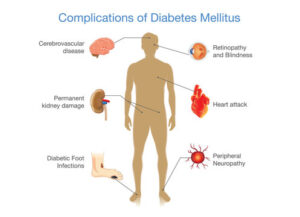
Diabetes increases the risk of heart and blood vessel problems. These include coronary artery disease with chest pain (angina), heart attack, stroke, narrowing of arteries (atherosclerosis), and high blood pressure.
Too much sugar in the blood can damage the walls of the small blood vessels (capillaries) that supply nerves. This is especially true for legs. This could result in tingling, numbness, discomfort, or burning. It usually starts at the tip of the toe or finger and spreads upward. Poor blood sugar control can lead to loss of all sensation in the affected limb over time. Damage to nerves that affect the digestive system can cause nausea, vomiting, diarrhoea, or constipation problems. In men, erectile dysfunction can be a problem.
Type 1 diabetes
Type 1 diabetes, formerly known as juvenile diabetes or insulin-dependent diabetes, is a chronic disease. In this state, the pancreas produces little or no insulin. Insulin is a hormone that the body uses to take sugar (glucose) into cells to produce energy.
Different factors, such as genetics and some viruses, may cause type 1 diabetes. While type 1 diabetes typically appears in childhood or adolescence, it can also strike adults.
There is still no cure for type 1 diabetes, despite much research. The goal of treatment is to prevent problems by controlling blood sugar levels with the use of insulin, food, and lifestyle changes.
Diabetes can damage the blood vessels in the retina (the part of the eye that sees light) (diabetic retinopathy). This can lead to blindness. Diabetes also increases the risk of other serious vision problems such as cataracts and glaucoma.
Nerve damage and poor circulation in the feet increase the risk of foot complications. Cuts and blisters can develop into dangerous infections if not treated. Toe, foot, or limb removal may be required for the treatment of certain infections (amputation).
Diabetes increases the risk of heart and blood vessel problems. These include coronary artery disease with chest pain (angina), heart attack, stroke, narrowing of arteries (atherosclerosis), and high blood pressure.
Too much sugar in the blood can damage the walls of the small blood vessels (capillaries) that supply nerves. This is especially true for legs. This could result in tingling, numbness, discomfort, or burning. It usually starts at the tip of the toe or finger and spreads upward. Poor blood sugar control can lead to loss of all sensation in the affected limb over time. Damage to nerves that affect the digestive system can cause nausea, vomiting, diarrhoea, or constipation problems. In men, erectile dysfunction can be a problem.

What are the complications that Type -1 Diabetes will lead to?
Over time, complications of type 1 diabetes can affect vital organs in the body. The heart, blood vessels, nerves, eyes, and kidneys are some of these organs. Having normal blood sugar levels reduces the risk of many complications.
Diabetes complications can lead to disabilities or even threaten your life.
Signs & Symptoms
Type 1 diabetes symptoms can appear suddenly and may include:
Increasing Appetite
Frequent Urination
Tingling in Limbs
Excessive Thirst
Blurry Vision
Wounds that don't heal
How to prevent Type 1 Diabetes?
There is no known method to prevent type 1 diabetes. But researchers are working to prevent disease and further damage to islet cells in newly diagnosed people.
Ask your healthcare provider if you’re a candidate for one of these clinical trials. Please give me. It is important to carefully weigh the risks and benefits of each available treatment in trials.
Causes and Risk Factors
The exact cause of type 1 diabetes is not known. The body’s immune system, which normally fights harmful bacteria and viruses, destroys insulin-producing (islet) cells in the pancreas. Other possible causes are:
Risk Factors
Several factors can increase your risk of developing type 1 diabetes, such as:
Family History
People who have a parent or sibling with type 1 diabetes have a slightly higher risk of developing the disease
Genetics
Presence of certain genes increases risk of developing type 1 diabetes
Age
The initial peak occurs in children between the ages of 4 and 7 years. The second affects children between the ages of 10 and 14.
Geography
The number of people with type 1 diabetes tends to increase further from the equator

